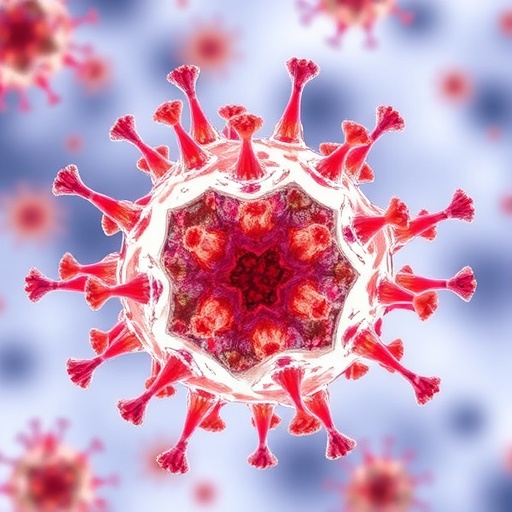In a groundbreaking study, researchers have devised an innovative methodology to reprogram the specificity of proteases, paving the way for an exciting landscape of possibilities in proteome editing and therapeutic applications. Using a sophisticated in vivo life–death selection system that emphasizes protease reprogramming, the team introduced a unique selection marker— the toxic N-terminal domain of gasdermin D (GD-N) protein. This inventive approach capitalizes on the inherent toxicity of GD-N to host bacterial cells, allowing researchers to manipulate protease mutations effectively through an elegant evolutionary mechanism.
The concept of using gasdermin D becomes particularly intriguing when it merges with directed evolution principles. The system is modular, offering a framework that spans the vast mutational landscape of proteases—an area teeming with diversity and potential applications. By embedding a specific cleavage sequence into the loop region of the GD-N protein, bacteria with successful mutations can be enriched following rounds of selection in liquid culture. This innovative design enables researchers to sift through an immense variety of protease mutations with remarkable efficiency.
In their experiments, the researchers employed the tobacco etch virus protease (TEVp) as a model protease, showcasing how this platform can be utilized to isolate and enrich protease variants that demonstrate enhanced substrate cleavage capabilities. This is particularly important since such advancements could significantly impact the manipulation of proteins involved in various diseases, providing a method to target and cleave proteins that may contribute to pathological states. By selecting variants capable of enabling cleavage while mitigating GD-N’s toxic effects, the researchers successfully enriched the desired trait, demonstrating a millionfold increase in efficiency after just a single round of selection.
Moreover, the implications of this research extend far beyond basic science; they touch on therapeutic interventions and potential medical breakthroughs. The ability to tailor protease specificity could revolutionize strategies for combatting diseases where aberrant protease activity plays a crucial role. By refining the ability of proteases to cleave specific target sequences on proteins associated with certain pathologies, researchers hope to offer novel solutions for therapeutic interventions that previously seemed unattainable.
Throughout their study, the researchers emphasized the versatile nature of the system and its capacity to accommodate a multitude of target sequences. This adaptability is increasingly vital in the context of the proteomic complexities observed in various biological systems. The capacity to harness directed evolution in such a manner could enhance our understanding of protease functions and enable scientists to engineer proteases that can operate in a disease-specific manner.
An essential aspect of the evolved TEVp variant lies in its proficient recognition and cleavage of target sequences on proteins linked to recognized pathological roles. The studies surrounding the pathological implications reveal a promising trajectory where targeted protease application can alter the functional landscapes of these disease-contributing proteins. This newfound capability to engineer precise proteases marks a significant step forward in molecular biology and therapeutic development.
In relation to the potential for protein engineering, the techniques demonstrated in this research lay the groundwork for further exploration of protease biology. As scientists delve into the intricacies of protease structures and their interactions with target substrates, the evolutionary principles highlighted in this work could elevate research efforts across various disciplines. The integration of the GD-N system within proteomics significantly eases the process of identifying and characterizing protease variants with desirable properties.
Moreover, the researchers point out the safety aspects of their methodology, noting that due to the toxic nature of GD-N, only those bacteria capable of adapting through successful cleavage mechanisms are likely to survive and proliferate. This selective pressure fosters a more efficient exploration of protease capabilities, ensuring that high-functioning variants emerge from the evolutionary process.
The multidisciplinary approach to this research underscores the collaborative nature of contemporary science, where concepts from various fields converge to spark innovation. By harnessing insights from proteomics, evolutionary biology, and molecular medicine, the researchers have crafted a novel tool that could redefine how scientists approach protease engineering and broader therapeutic applications.
Emerging from this study is the notion that reprogramming proteases with this system may serve as a springboard for other endeavors in biotechnology and medicine. For example, the ability to rapidly evolve new protease tools could lead to customized reagents for biosensing applications or precise editing technologies in genetic research.
The implications of successfully engineering proteases are far-reaching, suggesting a future where tailored enzymatic tools can be readily generated to address specific challenges in research and therapeutics. Such advancements could enhance precision medicine approaches, creating a more refined means of targeting disease mechanisms at their source.
As this research gains traction in the scientific community, it is anticipated that the life-death evolution system will inspire a wave of applications in fields such as synthetic biology and drug development, where proteases serve as critical components in developing new therapeutic strategies. Excitement courses through the community at the prospect of control over protease specificity, promising transformative impacts across medicine and beyond.
In conclusion, the study exemplifies how innovative thinking in biological research can catalyze breakthroughs with profound implications for the future of therapeutic interventions. By coupling toxic selection markers with directed evolution, researchers might have unlocked a powerful new tool that redefines our approach to studying and manipulating proteases, heralding a new era of targeted therapeutic possibilities.
Subject of Research: Protease Reprogramming
Article Title: A gasdermin-based life–death evolution system for reprogramming protease specificity
Article References:
Gao, Z., Li, T., Ye, H. et al. A gasdermin-based life–death evolution system for reprogramming protease specificity. Nat Chem Biol (2025). https://doi.org/10.1038/s41589-025-02063-3
Image Credits: AI Generated
DOI: https://doi.org/10.1038/s41589-025-02063-3
Keywords: protease specificity, gasdermin D, directed evolution, therapeutic interventions, proteome editing.
Tags: directed evolution of proteasesevolutionary mechanisms in biotechnologygasdermin D evolution systemGD-N toxic domainin vivo selection systemsinnovative protease engineeringmutational landscape of proteasesprotease mutation enrichmentproteome editing techniquesreprogramming protease specificitytherapeutic applications of proteasestobacco etch virus protease model





